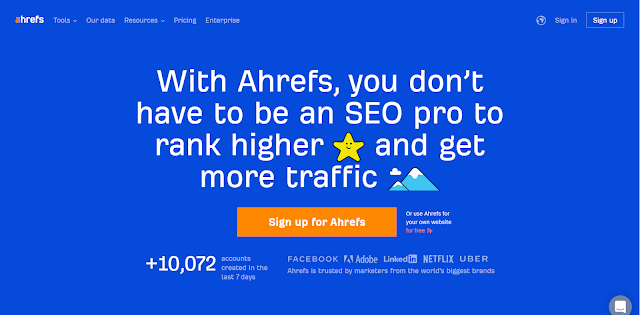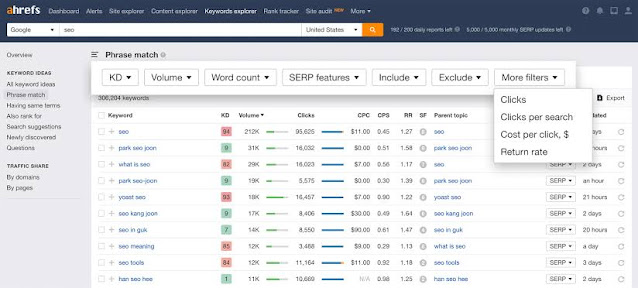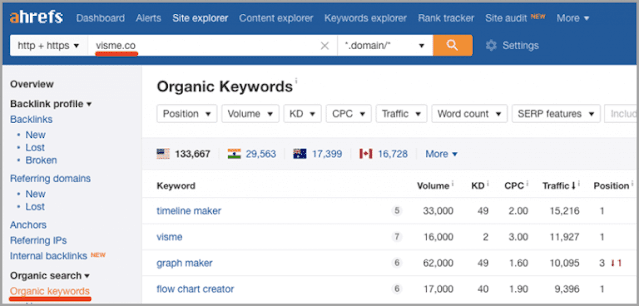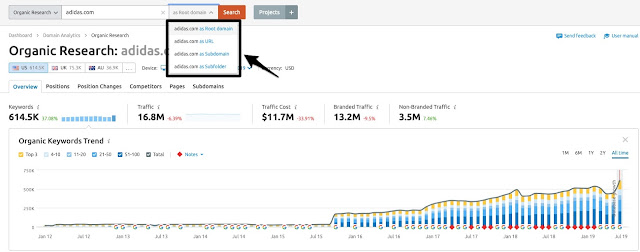SEMrush and Ahrefs are among
the most popular tools in the SEO industry. Both companies have been in
business for years and have thousands of customers per month.
If you’re a professional SEO or trying to do digital
marketing on your own, at some point you’ll likely consider using a tool to
help with your efforts. Ahrefs and SEMrush are two names that will likely
appear on your shortlist.
In this guide, I’m going to help you learn more about
these SEO tools and how to choose the one that’s best for your purposes.
What is SEMrush?
SEMrush is a popular SEO tool with a wide range of
features—it’s the leading competitor research service for online marketers.
SEMrush’s SEO Keyword Magic tool offers over 20 billion Google-approved
keywords, which are constantly updated and it’s the largest keyword database.
The program was developed in 2007 as SeoQuake is a
small Firefox extension
Features
- Most accurate keyword data: Accurate keyword
search volume data is crucial for SEO and PPC campaigns by allowing you to
identify what keywords are most likely to bring in big sales from ad clicks.
SEMrush constantly updates its databases and provides the most accurate data. - Largest Keyword database: SEMrush’s Keyword
Magic Tool now features 20-billion keywords, providing marketers and SEO
professionals the largest database of keywords. - All SEMrush users receive daily ranking data, mobile
volume information, and the option to buy additional keywords by default with
no additional payment or add-ons needed - Most accurate position tracking tool: This tool
provides all subscribers with basic tracking capabilities, making it suitable
for SEO professionals. Plus, the Position Tracking tool provides local-level
data to everyone who uses the tool. - SEO Data Management: SEMrush makes managing your
online data easy by allowing you to create visually appealing custom PDF
reports, including Branded and White Label reports, report scheduling, and
integration with GA, GMB, and GSC. - Toxic link monitoring and penalty recovery: With
SEMrush, you can make a detailed analysis of toxic backlinks, toxic scores,
toxic markers, and outreach to those sites. - Content Optimization and Creation Tools: SEMrush
offers content optimization and creation tools that let you create SEO-friendly
content. Some features include the SEO Writing Assistant, On-Page SEO Check,
er/SEO Content Template, Content Audit, Post Tracking, Brand Monitoring.
Ahrefs
Ahrefs is a leading SEO platform that offers a set of
tools to grow your search traffic, research your competitors, and monitor your
niche. The company was founded in 2010, and it has become a popular choice
among SEO tools. Ahrefs has a keyword index of over 10.3 billion keywords and
offers accurate and extensive backlink data updated every 15-30 minutes and it
is the world’s most extensive backlink index database.
Features
- Backlink alerts data and new keywords: Get an
alert when your site is linked to or discussed in blogs, forums, comments, or
when new keywords are added to a blog posting about you. - Intuitive interface: The intuitive design of the
widget helps you see the overall health of your website and search engine
ranking at a glance. - Site Explorer: The Site Explorer will give you
an in-depth look at your site’s search traffic. - Domain Comparison
- Reports with charts and graphs
- JavaScript rendering and a site audit can identify SEO
issues. - A question explorer that provides well-crafted topic
suggestions
Direct Comparisons: Ahrefs vs SEMrush
Now that you know a little more about each tool, let’s
take a look at how they compare. I’ll analyze each tool to see how they differ
in interfaces, keyword research resources, rank tracking, and competitor
analysis.
User Interface
Ahrefs and SEMrush both offer comprehensive information
and quick metrics regarding your website’s SEO performance. However, Ahrefs
takes a bit more of a hands-on approach to getting your account fully set up,
whereas SEMrush’s simpler dashboard can give you access to the data you need
quickly.
In this section, we provide a brief overview of the elements
found on each dashboard and highlight the ease with which you can complete
tasks.
AHREFS
The Ahrefs dashboard is less cluttered than that of
SEMrush, and its primary menu is at the very top of the page, with a search bar
designed only for entering URLs.
Additional features of the Ahrefs platform include:
- You can see analytics from the dashboard, including
search engine rankings to domain ratings, referring domains, and backlink - Jumping from one tool to another is easy. You can use
the Keyword Explorer to find a keyword to target and then directly track your
ranking with one click. - The website offers a tooltip helper tool that allows
you to hover your mouse over something that isn’t clear and get an in-depth
explanation.
SEMRUSH
When you log into the SEMrush Tool, you will find four
main modules. These include information about your domains, organic keyword
analysis, ad keyword, and site traffic.
You’ll also find some other options like
- A search bar allows you to enter a domain, keyword, or
anything else you wish to explore. - A menu on the left side of the page provides quick
links to relevant information, including marketing insights, projects, keyword
analytics, and more. - The customer support resources located directly within
the dashboard can be used to communicate with the support team or to learn
about other resources such as webinars and blogs. - Detailed descriptions of every resource offered. This
detail is beneficial for new marketers, who are just starting.
WHO WINS?
Both Ahrefs and SEMrush have user-friendly dashboards,
but Ahrefs is less cluttered and easier to navigate. On the other hand, SEMrush
offers dozens of extra tools, including access to customer support resources.
When deciding on which dashboard to use, consider what
you value in the user interface, and test out both.
Rank Tracking
If you’re looking to track your website’s search engine
ranking, rank tracking features can help. You can also use them to monitor your
competitors.
Let’s take a look at Ahrefs vs. SEMrush to see which
tool does a better job.
Ahrefs
The Ahrefs Rank Tracker is simpler to use. Just type in
the domain name and keywords you want to analyze, and it spits out a report
showing you the search engine results page (SERP) ranking for each keyword you
enter.
Rank Tracker looks at the ranking performance of
keywords and compares them with the top rankings for those keywords. Ahrefs
also offers:
You’ll see metrics that help you understand your
visibility, traffic, average position, and keyword difficulty.
It gives you an idea of whether a keyword would be
profitable to target or not.
SEMRUSH
SEMRush offers a tool called Position Tracking. This
tool is a project tool—you must set it up as a new project. Below are a few of
the most popular features of the SEMrush Position Tracking tool:
All subscribers are given regular data updates and
mobile search rankings upon subscribing
The platform provides opportunities to track several
SERP features, including Local tracking.
Intuitive reports allow you to track statistics for the
pages on your website, as well as the keywords used in those pages.
Identify pages that may be competing with each other
using the Cannibalization report.
WHO WINS?
Ahrefs is a more user-friendly option. It takes seconds
to enter a domain name and keywords. From there, you can quickly decide whether
to proceed with that keyword or figure out how to rank better for other
keywords.
SEMrush allows you to check your mobile rankings and
ranking updates daily, which is something Ahrefs does not offer. SEMrush also
offers social media rankings, a tool you won’t find within the Ahrefs platform.
Both are good which one do you like let me know in the comment.
Keyword Research
Keyword research is closely related to rank tracking,
but it’s used for deciding which keywords you plan on using for future content
rather than those you use now.
When it comes to SEO, keyword research is the most
important thing to consider when comparing the two platforms.
AHREFS
The Ahrefs Keyword Explorer provides you with thousands
of keyword ideas and filters search results based on the chosen search engine.
Ahrefs supports several features, including:
- It can search multiple keywords in a single search and
analyze them together. At SEMrush, you also have this feature in Keyword
Overview. - Ahrefs has a variety of keywords for different search
engines, including Google, YouTube, Amazon, Bing, Yahoo, Yandex, and other
search engines. - When you click on a keyword, you can see its search
volume and keyword difficulty, but also other keywords related to it, which you
didn’t use.
SEMRUSH
SEMrush’s Keyword Magic Tool has over 20 billion
keywords for Google. You can type in any keyword you want, and a list of
suggested keywords will appear.
The Keyword Magic Tool also lets you to:
- Show performance metrics by keyword
- Search results are based on both broad and exact
keyword matches. - Show data like search volume, trends, keyword
difficulty, and CPC. - Show the first 100 Google search results for any
keyword. - Identify SERP Features and Questions related to each
keyword - SEMrush has released a new Keyword Gap Tool that
uncovers potentially useful keyword opportunities for you, including both paid
and organic keywords.
WHO WINS?
Both of these tools offer keyword research features and
allow users to break down complicated tasks into something that can be
understood by beginners and advanced users alike.
If you’re interested in keyword suggestions, SEMrush
appears to have more keyword suggestions than Ahrefs does. It also continues to
add new features, like the Keyword Gap tool and SERP Questions recommendations.
Competitor Analysis
Both platforms offer competitor analysis tools,
eliminating the need to come up with keywords off the top of your head. Each
tool is useful for finding keywords that will be useful for your competition so
you know they will be valuable to you.
AHREFS
Ahrefs’ domain comparison tool lets you compare up to
five websites (your website and four competitors) side-by-side.it also shows
you how your site is ranked against others with metrics
such as backlinks, domain ratings, and more.
Use the Competing Domains section to see a list of your
most direct competitors, and explore how many keywords matches your competitors
have.
To find more information about your competitor, you can
look at the Site Explorer and Content Explorer tools and type in their URL
instead of yours.
SEMRUSH
SEMrush provides a variety of insights into your
competitors’ marketing tactics. The platform enables you to research your
competitors effectively. It also offers several resources for competitor
analysis including:
Traffic Analytics helps you identify where your
audience comes from, how they engage with your site, what devices visitors use
to view your site, and how your audiences overlap with other websites.
SEMrush’s Organic Research examines your website’s
major competitors and shows their organic search rankings, keywords they are
ranking for, and even if they are ranking for any (SERP) features and more.
The Market Explorer search field allows you to type in
a domain and lists websites or articles similar to what you entered. Market
Explorer also allows users to perform in-depth data analytics on These
companies and markets.
WHO WINS?
SEMrush wins here because it has more tools dedicated to
competitor analysis than Ahrefs. However, Ahrefs offers a lot of functionality
in this area, too. It takes a combination of both tools to gain an advantage
over your competition.
Pricing
Ahrefs
- Lite Monthly: $99/month
- Standard Monthly: $179/month
- Annually Lite: $990/year
- Annually Standard: $1790/year
SEMRUSH
- Pro Plan: $119.95/month
- Guru Plan:$229.95/month
- Business Plan: $449.95/month
Which SEO tool should you choose for digital
marketing?
When it comes to keyword data research, you will become
confused about which one to choose.
Consider choosing Ahrefs if you
- Like friendly and clean interface
- Searching for simple keyword suggestions
- Want to get more keywords for different search engines
like Amazon, Bing, Yahoo, Yandex, Baidu, and more
Consider SEMrush if you:
- Want more marketing and SEO features
- Need competitor analysis tool
- Need to keep your backlinks profile clean
- Looking for more keyword suggestions for Google
Both tools are great. Choose the one which meets your
requirements and if you have any experience using either Ahrefs or SEMrush let
me know in the comment section which works well for you.
Note: This article have been indexed to our site. We do not claim legitimacy, ownership or copyright of any of the content above. To see the article at original source Click Here























